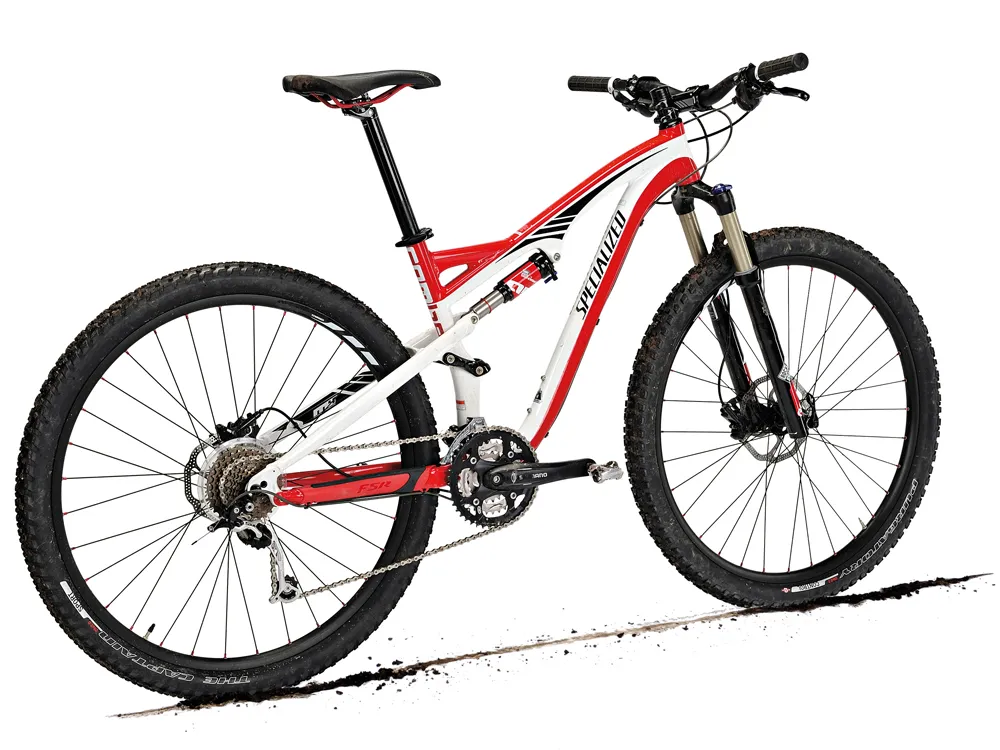Specialized came relatively late to the big-wheeled party but no-one could accuse the California-based company of not making up for lost time. They now make 26in- and 29in-wheeled versions of most of their key models. Tested here is the entry-level Camber 29, which comes in under the magic £2k mark with a decent-looking spec list.
The Camber has impressed us in the past, in both 26in and 29in versions, and it continues to do so here. The Camber 29 is a bit heavy next to the competition but the superb handling and wallet-friendly price make up for that. For an affordable entry into big-wheeled full-suspension it’s hard to beat. It's won over some hardened sceptics, so if you’re unsure, book a test ride.
Ride & handling: Thoroughly sorted 29er handling in a great value and easy-to-live-with package
Our earliest experience of a big-wheeled Camber was a ride on a pre-production carbon version. We came away impressed with its versatility in a whole variety of trail conditions. It combines the kind of race-bred athleticism that’s capable of demolishing tough climbs with a sure-footed nimbleness on descents that’s normally the preserve of quicker-handling 26in-wheeled bikes.
The good news is that the entry-level model preserves almost all of the carbon version’s winning attributes. Of all the 29ers we’ve ridden, the Camber is one of relatively few that comes close to mimicking a 26in bike in terms of both high- and low-speed handling, with a front end that all but eliminates any sense of big wheel inertia. Pedal, point, go.
This sure-footed nimbleness makes it instantly likeable, while the big wheels’ ability to roll up and over the kind of stutter bumps that’ll halt a smaller wheeled bike in its tracks helps to compensate for the bike’s slightly oversize waistline. In fact, although we grumbled inwardly every time we had to manhandle the Camber 29 (on and off a bike rack, or over a gate), when it came to pedal power it never seemed to be an issue.
It lacks the sprightly skip of lighter (and more expensive) competitors but for long-haul epics that’s not necessarily a bad thing. It wouldn’t be our first choice for a potential podium finish but for all-round trail duties with fun along the way, its combination of value and performance is hard to argue against.
Frame & equipment: Budget-squeezing component choices have pushed weight up
While the 26in-wheeled Cambers have 120mm of travel, the 29ers have 110mm… except this one, which has 100mm. It’s down to the fact that this base model uses the M4 aluminium frame of the original 2010 Camber 29 instead of the updated M5 frame used on the pricier Camber Comp 29. It wasn’t possible to adapt the older frame to accommodate more bounce, and it also has standard 135mm dropouts instead of the 142mm dropouts used throughout the rest of the 2012 range.
Specialized put great effort into reconciling the engineering and aesthetic components of their frame designs, so that the result both looks right and performs well. The Camber 29’s smooth, flowing lines and inline shock, seatstays and top tube are no coincidence. The curved down tube helps distribute stress away from the head tube area without the need for a gusset, while the inline stuff is all about improving small bump response and reducing frame weight by making each tube as short as possible.
There’s no doubt that Specialized’s designers have performed a minor miracle shoehorning all the important stuff into a big-wheeled bike and making it ride so well. But you can tell they live and ride in southern California. The Camber 29’s mud clearance at both ends is on the tight side of minimal and, although we had no issues, it’d be a concern for regular use in muddy conditions. All-up weight is another point of contention. The Camber is on the wrong side of 30lb and although it has a price advantage over some of its competition, it could certainly do with losing a few grams.
Bump munching duties are taken care of by a pair of RockShox air springs – an Ario shock at the rear and a Recon Gold fork up front. They’re well matched, although the Ario’s lack of adjustable compression damping might have some riders reaching for the lockout lever on long, smooth climbs. Specialized’s in-house kit takes care of most of the ancillary components, including a saddle that should prove comfortable for long days out.
Fitting a bigger profile tyre on the front isn’t a new idea – Kona did it a lot in the ‘90s. We don’t see it so often now, though, so the Camber 29’s big volume Purgatory front tyre is a novelty. It works well, giving the front of the bike extra bite in the corners and helping the big wheel reduce the fork’s workload in the rough stuff.
The only obvious area of cost-cutting in the Camber 29's spec is in the transmission, with a downgrade to nine-speed. Although many riders will expect 10-speed at this price, in functional terms there’s nothing to choose between them. A Deore XT rear mech adds showroom appeal and the Shadow design helps keep it out the way of rocks.

This article was originally published in What Mountain Bike magazine.
